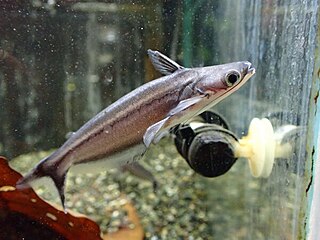
Callichthyidae is a family of catfishes, called armored catfishes due to the two rows of bony plates along the lengths of their bodies. It contains some of the most popular freshwater aquarium fish, such as many species in the genus Corydoras.

Hypostomus is a genus of catfish in the family Loricariidae. They are native to tropical and subtropical South America. H. plecostomus is the popular freshwater aquarium fish formerly known as Plecostomus plecostomus. The taxonomic structure of the Loricariidae is still being expanded by scientists. Hypostomus is a highly species-rich and widely distributed catfish genus.

The Doradidae are a family of catfishes also known as thorny catfishes, raphael catfishes or talking catfishes. These fish are native to South America, primarily the Amazon basin and the Guianas.

The Cetopsidae are a small family of catfishes, commonly called the whale catfishes.

The Aspredinidae are a small South American family of catfishes also known as the banjo catfishes, with about 43 species.

The loach catfishes are a family, Amphiliidae, of catfishes. They are widespread in tropical Africa, but are most common in streams at high elevations; most species are able to cling to rocks in fast-flowing streams. The 13 genera contain 68 species.
Scoloplax is the only genus in the catfish family Scoloplacidae, the spiny dwarf catfishes.

Auchenipterichthys is a genus of driftwood catfishes found in South America.

Leiarius is a genus of long-whiskered catfishes native to South America. Most of the genus' species are found in the aquarium hobby as ornamental fish.
Cetopsidium is a genus of catfishes of the family Cetopsidae.

Paracetopsis is a genus of whale catfishes found in tropical South America.
Denticetopsis is a genus of catfishes of the family Cetopsidae.

Cetopsis is a genus of catfishes of the family Cetopsidae.

Entomocorus is a genus of catfishes of the family Auchenipteridae.

Auchenipterus is a genus of driftwood catfishes.
Denticetopsis praecox is a species of whale catfish endemic to Venezuela where it is known from the Baria River of the upper Rio Negro basin. This species grows to a length of 5.3 cm.
Denticetopsis royeroi is a species of whale catfish endemic to Venezuela where it is only known from the holotype collected in a tributary to the upper Rio Negro. This species grows to a length of 1.8 cm.
Denticetopsis seducta is a species of whale catfish endemic to Brazil where it has a relatively wide, albeit scattered, distribution in the central and western portions of the Amazon basin and possibly the southwestern portions of the Orinoco River basin; it is relatively disjunct from the other species of Denticetopsis. It grows to a length of 5.1 cm.

Helogenes marmoratus is a species of whale catfish occurs in Brazil, Ecuador, French Guiana, Guyana, Peru, Suriname and Venezuela. It is found in the Atlantic drainages of the Guianas, the upper Orinoco and Rio Negro systems, and the upper Amazon River basin. This species grows to a length of 7.3 cm.

Cetopsis candiru, also known as candiru, candiru açú, candiru cobra or canero, is a carnivorous species of whale catfish found in the Amazon basin of Peru, Brazil and Bolivia. Similar to Cetopsis coecutiens, Cetopsis candiru is a large species of the genus Cetopsis and a widespread scavenger, known for its voracious feeding and the habit of burrowing into the carcasses of dead animals and humans. Despite its name, it is not closely related to the bloodsucking Candiru.













